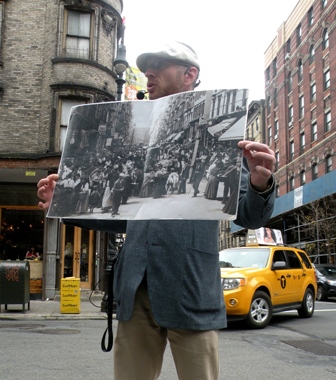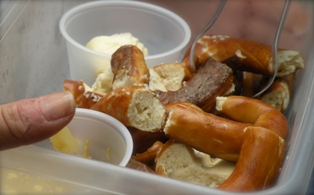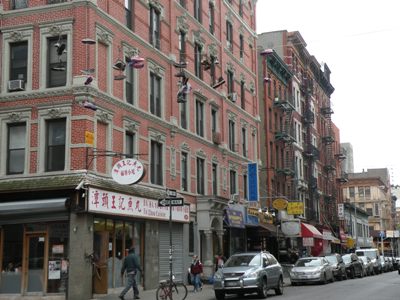
Tour highlights foods of Lower East Side
NEW YORK — The U.S is often referred to as the melting pot of the world, thanks to the large number of immigrants who came from many parts of Europe, Asia, and other parts of the world between the mid 19th Century and World War II that mixed into the existing culture they found in the new country.
However, a more accurate description may be to call it a patch quilt. Immigrants did not succumb and lose their values, religious traditions, culture and cuisine, but they kept them and incorporated them into traditions which they founded here.
| Click on the video at the left to see an audio slideshow narrated and prepared by writer Mari Centeno about the food tour on the Lower East Side. |
After the war, and with more intensity in the mid and late 20th Century, the immigrant population included large numbers of people from the Caribbean, Central and South America, and Asian countries that joined the peoples and cultures of the many Europeans that preceded them.
Even though the natural tendency of the new comer was, and continues to be, staying together and forming their own neighborhoods, some aspects of their culture and traditions couldn’t be contained and have become part of the general American life. Probably, the most noticeable of those aspects is related to the immigrant cuisine and the cultural values attached to food and eating.
Across the U.S. we can find small neighborhoods representing various cultures of the world. Some examples are Little Italy in New York, consisting of Italian stores and restaurants, Chinatowns, which can be found here, in Los Angeles and in San Francisco; and Little Havana, a predominantly Cuban neighborhood and booming tourist destination in Miami.
American food and culture has been greatly influenced by immigrant cultures for more than 100 years. Eating is not only something we need to do to survive, but also something we enjoy doing. We are constantly being influenced and exposed to food on television, magazines, while driving through our cities, and thanks to the people we meet. Food in the United States today is as diverse as the people that live here.
Until a few years ago, it wasn’t easy to find in one place information about how some of these immigrant colonies found their way into our American culture. However, in recent decades, some organizations in the United States have been dedicating their efforts and resources to preserve and communicate the history of some of those immigrant groups that helped form the American patch quilt.
| Adam Steinberg, tour guide for Foods of the Lower East Side, shows guests a photograph of what the streets may have looked like during the booming years of 97 Orchard St., in Manhattan (Photos by Mari Centeno). |  |
One of the examples of their work is the Lower East Side Tenement Museum in New York City. When the city of New York started to grow, and there was no room for one-family row houses, the solution was to modify them into multi-family buildings. These dwellings became the homes for thousands of working-class immigrants that arrived in New York at the later part of the 19th Century.
Brief History of the Museum
The Lower East Side Tenement Museum, located at 97 Orchard St., on the Lower East Side of Manhattan focuses on the preservation of a historical immigrant building, and educating the public on the importance and history of immigrant cultures throughout the years, and how they have influenced us today.
The museum is housed in a five-story building that is said to have been home to more than 7,000 immigrant families from more than 20 nations, between the years 1863 and 1935.
In 1863 Prussian-born immigrant, Lukas Glocker, constructed the tenement building, mainly to house working-class immigrants and their families. Up until 1935, the building went through various upgrades, which included 16 individual-family apartments, retail spaces, indoor plumbing and electricity.
However, in 1935, the landlord at the time evicted all the residents and closed down the building until the Lower East Side Tenement Museum took-over its administration in 1988. A unique historical gem, the building currently reflects both 19th and 20th century living conditions and gives us an exclusive and realistic look of how immigrants lived between 1863-1935.
The Lower East Side Tenement Museum Today
Today the Tenement Museum has become a very popular destination for both tourist and locals. One of the things that set this museum apart from the rest is that you are only able to see and experience the museum through a guided tour. The museum offers three different tours that allow one to learn all about lives of immigrants and how they helped shaped the American world of today.
One can choose to tour the building and visit the restored apartments of past residents from different time periods. There are a variety of sub-tours to enjoy such as: Discovering how immigrants survived economic depressions, experiencing the heart of the immigrant saga through the music of Irish America, or exploring the layers of history in the Tenement’s architecture and design.
| Pretzels are one of the first foods you can try during your tour experience. The soft pretzels come from a restaurant called Loreley, and they are the intro to a brief history of a German saloon. |  |
If you choose to meet the residents, you will get a unique and realistic view about immigrants that lived at 97 Orchard St. Here you get to meet a Greek Sephardic family and interact with a costumed performer playing the role of 14-year-old Victoria Confino.
Lastly, you can choose to walk the neighborhood and discover the Lower East Side and the way immigrants helped shape the area and its culture.
Perhaps one of the most popular tours is the Foods of the Lower East Side (LES). This is a fun guided tour that takes you around LES and explains the immigrant experience and some ways immigrant foods have shaped American cuisine.
This tour is a particular favorite, because you get to eat foods along the way! Get ready to taste dumplings, tostones (fried plantains), cream puffs and much more during this tour.
Taking a look inside
Food is an important element in all our lives, and it is what helps define our culture. Each one of us can look back into our younger years and have one food item that, through smell or taste, stimulates our senses and brings a smile to our face.
Our cultures influence what foods we prepare for our families, social gatherings and develops our taste palettes. If we trace back far enough in our family trees we can actually see how others may have influenced our own cultures. The Foods of the Lower East Side tour is very unique, because it takes you through time on some of today’s popular foods.
The food tour starts in a classroom setting where people share memories of their favorite childhood foods. It is always amazing to see how diverse each of us is. From these stories you can get a picture of how immigrant foods have changed throughout our cultures and traditions.
After sharing a few brief memories with those in the room, the tour guides takes you outside through several LES restaurants where he shares brief history about certain cultures and gives you the opportunity try some of today’s most popular foods.
 |
One of the streets visited during the Foods of the Lower East Side tour. |
The food that English and Northern Europeans brought to America was basically lacking in flavor, and mainly boiled. Perhaps we could say that this was a reflection of their strict conservative views of life; it was a food of little color and what today we would consider boring.
When the Southern Germans, Italians and Irish were added to the mix, we started to see a bit more spice and color. Also, both Germans and Italians showed Americans the relationship of special foods associated with celebrations, such as weddings and religious holidays.
The Jews brought with them the religious traditions associated with food preparation and kosher meals, and most of us like the flat bread and the bagels they introduced into our diets.
Today we eat pretzels, barbeque, coleslaw, hot dogs and numerous types of sausages, donuts, and hamburger thanks to the Germans; they also taught us how to make beer. From the Italians, we have rich-flavored tomato sauces, pastas and pizzas.
The culture of the Caribbean countries brought to America the rhythm of their music and the color and aromatic flavor of their dishes. We learned to eat rice with black beans and tostones, which are a delicious alternative to french fries, made from fried slices of green plantains (a type of banana used only for cooking).
Many young Americans today can’t imagine that there was a time when to eat a taco or an empanada, you had to cross the border, and herbs and spices such as chipotle peppers and cilantro weren’t available in your supermarket.
The people of the world that have made America their country in the last century and a half have made us a nation with a multicultural cuisine. And it is in this aspect that we could say America has been a melting pot, because even though we may not all speak the language of our immigrating grandparents or other relatives, most of us have incorporated to that special family recipe a touch of seasoning that we borrowed from somebody else’s someone else. Pizza started out being Italian, but today we have New York style pizza and many others.
Some foods have become so popular that people think we have always had them, like sushi. All of a sudden, sushi bars are competing with fast food hamburger joints, and at this point it is interesting to mention that our culture of fast-pace always, on the go type, has been able to take traditional dishes from those immigrant communities and come-up with the fast food version we need.
The Tenement Museum food tour gives everyone not just a history lesson, but also an opportunity to learn about some of the foods we all love to keep around. From pretzels, to chocolates, to tostones, and pickles, foods tend to always find their way into the center of any social gathering in many cultures.
This tour is completely different from any other museum tour you may have experienced. You are literally walking through the same neighborhoods people from the 19th and 20th century walked, shopped and worked on.
The tour is full of energy and is very interactive and informative. Although you cover a lot of areas in the two-hour tour package, the guide does offer names and addresses of all the places you visited so you can go back and buy some of your favorite items.
After you have walked through various LES blocks, the tour group meets back in the classroom where they close the tour with some delicious food items. This is the time where you get to share memorable moments and ask any questions you may have.
Just in case you feel you didn’t get enough information, the Tenement Museum has bookshelves full of books ranging in a variety of topics. From cookbooks, to history books, maps, calendars and much more, your visit to the Tenement museum is sure to leave a few memorable impressions.
If You Go
The Lower East Side Tenement Museum
103 Orchard St., New York, N.Y. 10002
212-982-8420
http://www.tenement.org/
Buy your tickets online. Tours sell out quickly, especially during high seasons.
http://www.tenement.org/
The Foods of the Lower East Side tour offers both an indoor and outdoor tour depending on the weather.
Bring an open mind and lots of energy. The outdoor foods tour requires some walking, but the food you taste along the way is worth it.

Comments are Closed